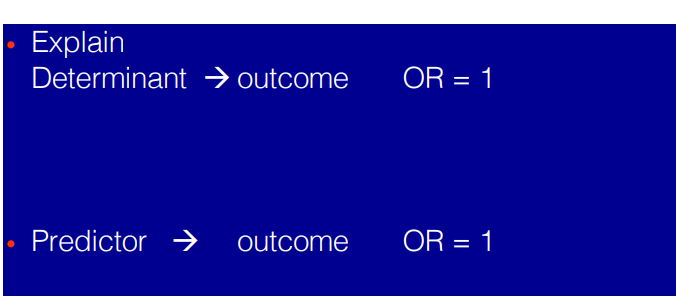RHMS - lecture 8 - risk factors versus prediction of outcome
1/16
There's no tags or description
Looks like no tags are added yet.
Name | Mastery | Learn | Test | Matching | Spaced |
|---|
No study sessions yet.
17 Terms
NEED TO KNOW;
basics observation studies
measures of association
risk difference (absolute risk reduction)
relative risk
odds ratio
number needed to treat
attributable proportion in the exposed (APe)
attributable proportion in the (total ) population (APt)
selection bias and information bias, condounding and effect modification EXAM MATERIAL
difference between studying risk factors versus the development of prediction models (main part this lecture)
case control study
researcher looks backward in time to see how frequently the exposure to a potential risk factor occurred in each group
cases → individuals who already have the disease or outcome of interest
controls → individuals who do not have the disease, but are otherwise similar to the cases.
Usually retrospective, but can be prospective in some designs
measure of association → odds ratio, often not risk ratio
information bias
systemic errors in the way data are collected, measured, recorded
common types of information bias
recall bias → participants remembering past events differently
interviewer bias → interviewers tone, wording, behaviour influence response
response / social desirability bias → participant answer in desirable way
pros cons case control studies
pros;
Rare ‘disease’ (occurrence of interest)
Efficiency
Relative small N (With same precision of effect estimate as in cohort study)
cons;
Validity comprised and not easy established
Selection bias (wrong control group or wrong selection cases), information bias
Confounding & Effect modification
cohort studies
follow group of people over time to see how exposure to a risk factor affects the occurence of a specific outcome
start with exposure → classify participants based on whether they are exposed or not exposed → follow them over time → compare incidence
two types of cohort study
prospective → healthy population, collect exposure data, follow participants
retrospective → use existing records to classify participants by past exposure → look at outcomes that have already occured
summary → cohort studis assess cause - effect relationships. but often the causality as such is difficult to establish therefore epidemiologists often use association and cause-effect relationships.
pros cohort study
measurement at the individual level
follows the natural sequence (exposure → outcome) that is why it is longitudinal and prospective
more outcomes in one study (can study more diseases like diabetes and cardiovascular disease)
cons cohort study
costly and long duration
potential pre-selection due to early exposure (healthy worker effect)
difficult when incidence in outcome is low or if it has a long preclinical stadium
clear insight into relevant risk factors needed.
survivor bias
survivor bias happens when we only study those who remain
loss to follow up is a big cause of survivor bias → if only participants who remain in the study are analyzed, the results may be biased.
people lost to follow up may differ from those who stayed.
because of this you can never ignore missing data
limitations patient registries
data quality (clinical registries vary in how accurately and consistently data are entered can lead to information bias)
missing values → mainly confounders
reasons;
these registries were not designed for scientific research
in routine clinical practice everything that is additional to direct patient care should be short and simple.
aim cohort study
cohort study → observational, longitudinal study where a group of individuals is followed over time to observe whether they develop a specific outcome.
cohort study aims to examine the association between a (set of) main determinants and a future outcome.
one wants to have an unbiased association so control for confounding is important.
effect modification
occurs when the strength or direction of the association between an exposure and an outcome changes depending on the level of a third variable (the effect modifier).
when the relationship / effect between an exposure and an outcome differs across levels of a third variable
e.g. difference between man and women because they are this certain sex.
cohort studies for prediction models
which variables predict the outcome
to predict an occurrence of interest in the future we need longitudinal data
longitudinal data → consists of repeated measurements on the same subjects over multiple time points.
so, cohort studies are appropriate designs
validation
To determine to what extent the predictions / model is feasible or (too?) optimistic
Internal validation:
Validate in the setting / patients used to make the model
External validation
Validate in a new setting / new patients
why is prediction important
patients and clinicians want to know the prognosis
prognostic stratification
guides further clinical management
more specific diagnostic procedures
treatment or not
causality is not the main issue
how to develop prediction models
pre selection of potential predictors
literature / previous research
expert opinion
collect data in longitudinal study
cohort
registry data
selection of predictors statistically
many discussions on how to do this
explain versus predict
what is the different between an OR of 1 between explanation and predictor;
in prediction confounder is not important anymore (causality). not interested in causality.
in the top one when the OR is 1 than there is no association → important finding!!
in the predictor when the OR is one than it does not predict anything (so you can delete it out of your study).

TRIPOD statement
Transparent reporting of a multivariable prediction model for individual prognosis or diagnosis (TRIPOD)